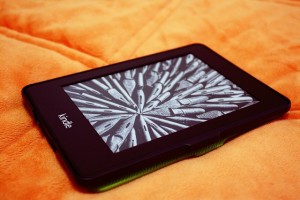If this is not a perfect analogy, but I think the new Kindle Paperwhite is the iPhone 5S of e-readers, or digital reading devices ink – looks almost identical to the original Paperwhite, but is faster and better.
For starters, the new Paperwhite is the first product available with Pear E Ink screen, which offers better contrast with a 1GHz processor (25 percent faster than the 800MHz on the original Paperwhite), an integrated light next generation touch screen more immediate response (1,024×768 pixel resolution and 212 pixels per inch), with a touch grid to 19 percent higher density. It is also a little lighter, weighing 7.3 ounces instead of 7.5 ounces.
Although the two models look the same (is now the logo of Amazon in the back instead of the Kindle), the most immediate difference you’ll notice is that the screen looks whiter – instead of having a slight blue tint – and the lighting is more even (the light is brighter at its peak).

If you compare it side by side with the original, the display of ancient Paperwhite a little bit dingy and gray looks (with a touch of blue). What the company says is officially “the whites are whiter and more black, so black pages are virtually indistinguishable from a paper book.” I would not go that far, but the screen-and experience-reading continues to improve and looks more like a printed book.
Amazon encourages you to read with the light, but not necessarily with the maximum brightness. It’s okay to easily adjust the brightness. Just use the controller on the screen to adjust the brightness level or turn off the light at all.
Sure there are people who do not like reading with the light on especially when they are in natural light (or in direct sunlight). With the lights out, it’s much more difficult to see the difference between the original and the new model Paperwhite. We liked that the text looks a little sharper with the lights off. David Katzmaier, our expert video editor, using the Kindle Touch 2011 (now discontinued) regularly and was not a fan of the lighting scheme of the original Paperwhite 2012. However, says that given the current options, opt for the new Kindle Paperwhite on using, as the most basic Kindle (US $ 69) that has no self-illuminating touch screen.
Amazon says that the contrast has been increased, but it is difficult to see that blacks are black, even if it is so. (Peter Larsen, vice president of Kindle, told me that the percentage increase is “double-digit” although it varies slightly depending on each batch of e-ink, so it is difficult to put an exact number).
The new screen refresh requires less, which is sometimes referred to as flashing setup instructions. Electronic readers need to cool off from time to time to remove artifacts or what is known as “ghosting” (ghosting). The previous model every six page turns cooled off and in my tests with the new model was 13 or 14 pages each.
The battery life remains the same, up to 2 months with the Wi-Fi off even though the processor is now faster. To conserve battery is crucial to keep off the Wi-Fi. Actually you just have to turn on Wi-Fi to buy books or charge which you have stored in the cloud or download newspapers and magazines (requires a subscription). You can also read emails and articles of the web while the Paperwhite not have much storage memory; it comes with 2GB storage memory (1.25GB available for user content), it says that according to Amazon can help you store up to 1,100 eBooks. A Japanese version will bring 4GB of storage.